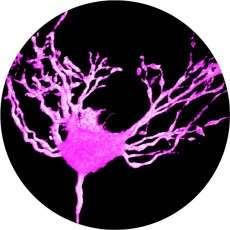Researchers and supercomputers to help create a standard 3D neuron model

Before scientists can unlock the secrets of the human brain, they must fully understand neurons—the cells of our brain, spinal cord and overall nervous system. Thousands of detailed neuron images, from different organisms, currently sit in individual data collections across the globe, comprising several petabytes of data altogether. Despite this plethora of data, made possible with advancements in brain cellular imaging, data standardization is still a major hurdle to gaining an accurate understanding about how neurons work.
Over the years, dozens of imaging paradigms and algorithms have been created for visualizing the 3D structure of neurons—leading to a variety of disparate datasets in the field. But neuroscientists widely agree that to solve the mysteries of the brain, they need to cross-compare these datasets. That's why many of the field's brightest minds are participating in BigNeuron, a community effort to define and advance the state of the art of single neuron reconstruction and analysis and create a common platform for analyzing 3D neuronal structure.
In an attempt to find a standard neuron reconstruction algorithm, BigNeuron will sponsor a series of international hackathons and workshops where contending algorithms will be ported onto a common software platform to analyze neuronal physical structure using the same core dataset. All ported algorithms will be bench-tested at Department of Energy supercomputing centers—including the National Energy Research Scientific Computing Center (NERSC) at the Lawrence Berkeley National Laboratory (Berkeley Lab) and the Oak Ridge Leadership Computing Facility (OLCF) at the Oak Ridge National Laboratory (ORNL)—as well as Human Brain Project supercomputing centers, allowing the community to standardize optimal protocols for labeling, visualizing and analyzing neuronal structure and key biological features.
The data generated by these benchmark runs will be used to develop a comprehensive annotated database of complex neuronal morphology, generate a searchable tool for discovering annotated and unique characteristics of neuronal morphology and lay the groundwork for potentially integrating this tool with large-scale data sets linking form to neuronal function. In addition, researchers will be able to access it via the Collaborative Research in Computational Neuroscience (CRCNS) data-sharing portal hosted by NERSC, which allows neuroscience researchers worldwide to easily share files without having to download any special software.
"BigNeuron highlights NERSC's strengths as a unified facility where people can run sophisticated data analytics algorithms and simulations and a worldwide community of researchers can easily access the results over the Internet," says Prabhat, leader of NERSC's Data and Analytics Services Group and BigNeuron collaborator.
"For more than 40 years NERSC has served as a scientific computing center and archive for thousands of researchers at national laboratories and universities around the world. Our users are investigating a variety of problems from climate to combustion, and we've developed a robust infrastructure to support their needs," says Sudip Dosanjh, NERSC Director. "Our participation in the BigNeuron effort is an extension of the work that we've been doing for four decades."
More information: BigNeuron Factsheet: alleninstitute.org/bigneuron/overview/



















